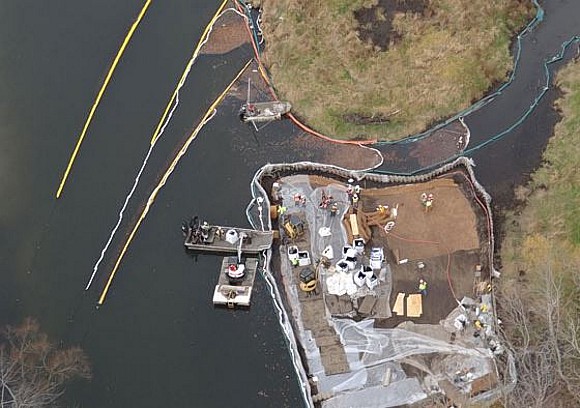Ten Companies Agree to Final Phase of Toxic Cleanup of New Jersey Industrial Waste Site
 May 23, 2014
May 23, 2014  Kyriaki (Sandy) Venetis
Kyriaki (Sandy) Venetis Ten companies have reached an agreement with the U.S. Environmental Protection Agency for the final phase of a $1.4 million cleanup of the Evor Phillips Leasing Co. Superfund site in Old Bridge Township, NJ. The New Jersey District Court approved the proposal earlier this month.
 Evor Phillips Leasing Co. Superfund site in Old Bridge Township, NJ. Photo courtesy of dredgingtoday.com.
Evor Phillips Leasing Co. Superfund site in Old Bridge Township, NJ. Photo courtesy of dredgingtoday.com.The site is an unoccupied six-acre plot of land located about one mile west of Route 9 and about 1.5 miles northeast of Route 18. The groundwater beneath the six-acre site is contaminated with volatile organic compounds (VOCs) from past industrial activities. The soil is also contaminated with VOCs and metals.
The EPA warns that direct contact with the soil, or accidentally ingesting of contaminated soil or groundwater could create serious health issues, including cancer.
The extent and nature of the potential health effects depends on factors including the level and length of exposure to the pollution, said the agency.
Municipal well data has confirmed the presence of site-related contaminants in the groundwater with leaching occurring into the underlying aquifer, which is a source of drinking water.
Among the most at risk are the Sayreville municipal wellfield located about 1,000 feet southwest of the site, and the Perth Amboy wellfield located about 3,000 feet southwest of the site. “All nearby residents have discontinued use of private wells and are now served by a municipal water supply,” said the EPA.
The site has a long history of producing unchecked toxic waste. From 1970 to 1986, activities at the site included industrial waste treatment, oil recovery, and metal reclamation operations. Liquid waste was treated at the property and two waste treatment ponds were used at the site for neutralizing acidic and caustic (corroding) wastewater.
Also during this time, 19 horizontal furnaces were used to recover silver and other precious metals by incinerating photographic film and printed circuit boards.
The New Jersey Department of Environmental Protection closed down the liquid waste treatment operations in 1974 after the operations failed to comply with state environmental requirements. All operations at the site stopped in 1986 with the shutdown of the metal recovery furnaces.
The cleanup is now entering the third phase. The site was listed on the EPA’s Superfund list of the nation’s most hazardous waste sites in 1983. The first phase involved the initial removal of about 40 buried drums and soil contaminated by metals and was conducted by the New Jersey Department of Environmental Protection (NJDEP).
Later in 1996, excavations “unearthed over 1,000 buried waste containers in six areas of the site,” said the EPA.
As part of the response to the contamination, a groundwater treatment system was constructed to prevent the contaminated groundwater from moving off the site. During this time, several companies responsible for the contamination began operating the groundwater treatment system with the oversight of the NJDEP.
These companies were also tasked with demolishing office buildings and furnaces as well as removing buried drums, contaminated soil, and underground storage tanks.
In 2008, the EPA took over lead oversight that marked phase two of the cleanup, which saw the process of removing contaminated soil completed.
The new agreement reached this month launches the third phase of the cleanup, which will involve the long-term treatment of groundwater using a process known as “chemical oxidation.”
The EPA explained that, “Chemical oxidation uses chemicals to destroy pollution in soil and groundwater, breaking down the harmful chemicals into water and carbon dioxide.”
The agency explained the process, saying that the oxidants would be pumped into the groundwater at different depths, targeting polluted areas, and each injection would be followed by monitoring to evaluate the effectiveness of the treatment.
The EPA added that it will continue to monitor the groundwater for several years after the cleanup is completed to verify that it’s “no longer a source of contamination.”
The companies conducting the cleanup are: Cabot Corporation, Carpenter Technology Corporation, CWM Chemical Services, LLC, Ford Motor Company, International Flavors and Fragrances Inc., Johnson Matthey, Rutgers Organics Corporation, Spectraserv, Inc., Spiral Metal Company, LLC and Waste Management of New Jersey, Inc. with EPA oversight of the work.
Related Resources
Reader comments and input are always welcomed!

Reader Comments